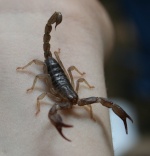pandinus
Hadogenes

Number of posts : 64
Age : 37
Location : Wichita, KS
Registration date : 2009-01-16
![[Info] Use Scorpion Morphology for Tips on Husbandry Empty](https://2img.net/i/empty.gif) |  Subject: [Info] Use Scorpion Morphology for Tips on Husbandry Subject: [Info] Use Scorpion Morphology for Tips on Husbandry ![[Info] Use Scorpion Morphology for Tips on Husbandry Empty](https://2img.net/i/empty.gif) 1/23/2009, 11:07 pm 1/23/2009, 11:07 pm | |
| you've just gotten a new species of scorpion, you have no idea how to care for it, you cant find any data, and the people on forums are too busy bickering to give you any tips. but there is hope. you can analyse the physical morphology of the scorpion for tips on how to car for it properly.
there are four basic types of scorpions in terms of morphology:
psalmophillic scorpions- sand-dwelling scorpions, often dwelling and burrowing in sand and other soft substrates
lithophillic scorpions- rock-dwelling scorpions, living in rocky areas, often adapted to life in cracks of rocks and under stones
fossorial scorpions- obligate burrowing scorpions that live in deep burrows & ambush prey, only leaving typically to mate
errant scorpions- the "bark scorpions", living opportunistically on varried substrates on the ground and in vegetation, etc
each scorpion is adapted to its environment, and you can interpret these adaptations to help you setup a proper environment. this guide is largely a summary of a section of Polis' biology of scorpions, and to a lesser extend personal experience. regardless i think this is a good thread to have lying around on a scorpion forum.
psalmophillic scorpions- examples: Buthacus spp. Smeringus spp. hadrurus spp.
features- these scorpions are not particularly uniform in their body shape, and often times their coloration is adapted to match the color of their substrate. their pedipalps can also be varied in shape and size. polis states that the chelicera of psalmophiles are often long and slender, though to be honest, i think that it is rather difficult to examine chelicera of a live scorpion, so this may not be particularly useful. the metasoma of many psalmophile scorpions are typically streamlined. the key feature of psalmophiles is their legs. the legs are often elongated, with particularly long tarsi covered with long brushlike setae which help the scorpion to evenly distribute its weight on soft substrates keeping the feet from sinking in and slowing it down. these scorpions are very well adapted to live in shifting and soft substrates, and typically construct deep burrows in these substrates
lithophilic scorpions- examples: Isometrus maculata, Hadogenes spp. Iomachus spp. Syntropis spp.
features- these scorpions are adapted to life lived in and amongst rocks, and as such they need to be able to have a good grip to keep traction on stones both upright and upside-down, as well as being able to fti in to some tight spots. to help out with traction the tarsi are often heavily curved with well developed claws to help them grip the surface. the bodies of these scorpions are dorsal-ventrally compressed as are the legs to make theyre bodies as flat as possible, enabling them to get into some very tight space. living in the cracks also means it's important to be able to reach into tight spaces, so pedipalps are often long and slender, as is the metasoma which is also laterally compressed. more noticable to me than on the psalmophiles, the chelicera of lithophiles are very powerfull, and also enlarged
Fossorial scorpions- examples: Pandinus spp. Urodacus spp. most Opistothalmus spp. most Diplocentrus spp.
features- not named so because they are primitive, quite the opposite, these scorpions are highly evolved. the name reffers to their subterrainian lifestyle. these obligate burrowers rarely venture away from thier burrows, often not going more than a few feet from the burrow entrance, except to mate in the case of the males. their entire body is adapted to life digging and burrowing. everything about them is powrful and formidable, and these are some of the largest scorpions in the world. the bodies are heavily constructed, being somewhat stocky or stout. the legs are short to function in the confines of burrows, but are also very stout and strong, as they are part of the arsenal of digging tools. the tarsi of the leg are similar to the legs as awhole in that they are very short, and the setae on the legs resemble short spines, which with the aid of the strong tarsal claws help the scorpion to dig through rough substrates. the pedipalps are incredibly well developed, being very large and powerfull stout appendages that often outweigh the telsons of these scorpions which are often greatly reduced, being in some cases less than half the body length, and with reduced telsons. the chelicera are also stout and powerful, and the powerfull chela, legs, and chelicera are what these scorpions use to dig their deep and sometimes elaborate burrows
Errant scorpions- examples: Centuruoides spp. Tityus spp. Uroplectes spp. lychas spp.
features- some experts do not recognise this group as valid, as it is highly variable and typically reffers to new world buthids or bark scorpions. Typically these scorpions can have feature of both psalmophiles and lithophiles as they have evolved to be opportunists living on a variety of habitats, rather than a single ecotype like the others. these scorpions are typically slender-bodied with long and thin pedipalps and metasomas. these scorpions are often arboreal, living in and around vegitation, including leaf litter, as well as under bark and in rotting logs. long dorsal-ventrally compressed legs often help them to hide under bark and lay flat against rocks and trees to avoid detection, and their lightweight bodies allow them to become nimble and agile climbers. the coloration of these scorpions usually matches their surroundings, and many have cryptic patterns on their bodies to help them blend into their surroundings and break up the outline of their bodies.
that's it for now. thanks for reading,
John
Last edited by GS on 11/27/2012, 9:54 am; edited 1 time in total (Reason for editing : Updated title) | |
|
~Abyss~
Administrator

Number of posts : 6472
Age : 36
Location : Los Angeles Cali.
Registration date : 2008-02-05
![[Info] Use Scorpion Morphology for Tips on Husbandry Empty](https://2img.net/i/empty.gif) |  Subject: Re: [Info] Use Scorpion Morphology for Tips on Husbandry Subject: Re: [Info] Use Scorpion Morphology for Tips on Husbandry ![[Info] Use Scorpion Morphology for Tips on Husbandry Empty](https://2img.net/i/empty.gif) 1/23/2009, 11:43 pm 1/23/2009, 11:43 pm | |
| Thats a great write up and I think on of the tehniques the most advance people use. Thats why i hardly ever ask questions anymore. I vote it get stickified? Any other A team wanna shine in? | |
|
Mr. Mordax
Administrator

Number of posts : 7743
Age : 38
Location : PNW
Registration date : 2008-02-06
![[Info] Use Scorpion Morphology for Tips on Husbandry Empty](https://2img.net/i/empty.gif) |  Subject: Re: [Info] Use Scorpion Morphology for Tips on Husbandry Subject: Re: [Info] Use Scorpion Morphology for Tips on Husbandry ![[Info] Use Scorpion Morphology for Tips on Husbandry Empty](https://2img.net/i/empty.gif) 1/24/2009, 12:50 am 1/24/2009, 12:50 am | |
| Stickify. I haven't read it yet, but if I know John's advice, it's worth it.  | |
|
pandinus
Hadogenes

Number of posts : 64
Age : 37
Location : Wichita, KS
Registration date : 2009-01-16
![[Info] Use Scorpion Morphology for Tips on Husbandry Empty](https://2img.net/i/empty.gif) |  Subject: Re: [Info] Use Scorpion Morphology for Tips on Husbandry Subject: Re: [Info] Use Scorpion Morphology for Tips on Husbandry ![[Info] Use Scorpion Morphology for Tips on Husbandry Empty](https://2img.net/i/empty.gif) 1/24/2009, 2:53 am 1/24/2009, 2:53 am | |
| wow! my first sticky, i should reward myself with a drink, oh wait i'm drinking already  | |
|
AshMashMash
Babycurus

Number of posts : 294
Age : 36
Location : London Baby
Registration date : 2009-01-14
![[Info] Use Scorpion Morphology for Tips on Husbandry Empty](https://2img.net/i/empty.gif) |  Subject: Re: [Info] Use Scorpion Morphology for Tips on Husbandry Subject: Re: [Info] Use Scorpion Morphology for Tips on Husbandry ![[Info] Use Scorpion Morphology for Tips on Husbandry Empty](https://2img.net/i/empty.gif) 1/24/2009, 10:38 am 1/24/2009, 10:38 am | |
| Awesome, very helpful  | |
|
Sponsored content
![[Info] Use Scorpion Morphology for Tips on Husbandry Empty](https://2img.net/i/empty.gif) |  Subject: Re: [Info] Use Scorpion Morphology for Tips on Husbandry Subject: Re: [Info] Use Scorpion Morphology for Tips on Husbandry ![[Info] Use Scorpion Morphology for Tips on Husbandry Empty](https://2img.net/i/empty.gif) | |
| |
|

